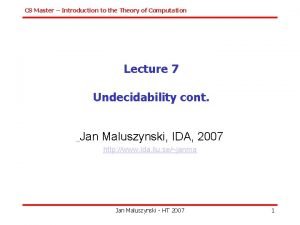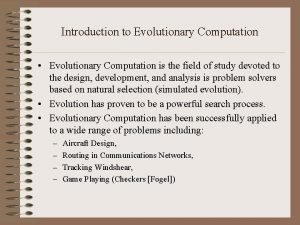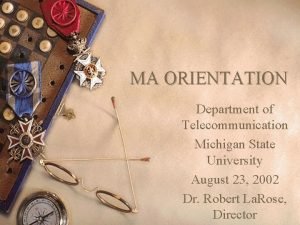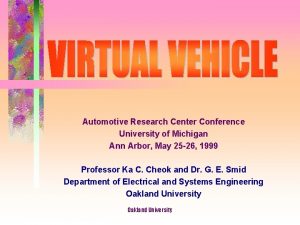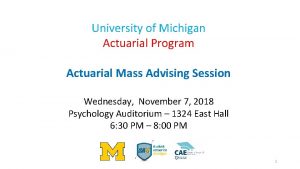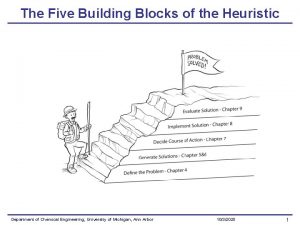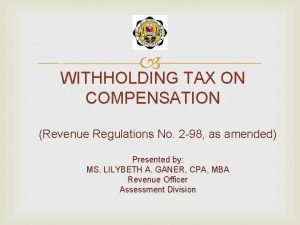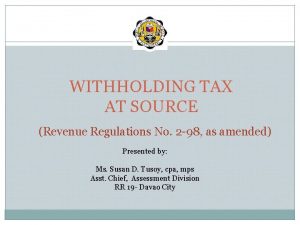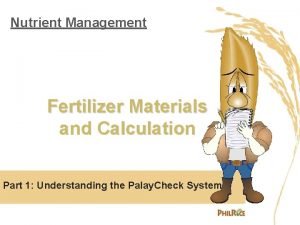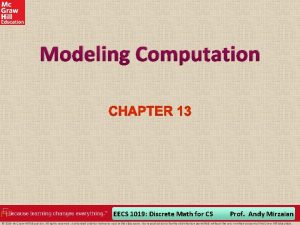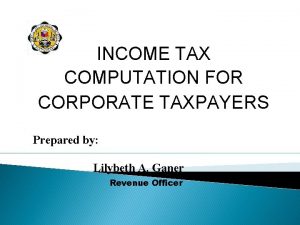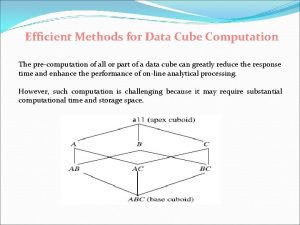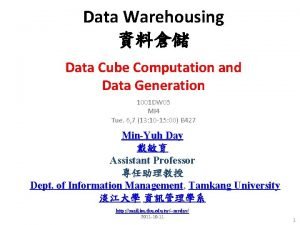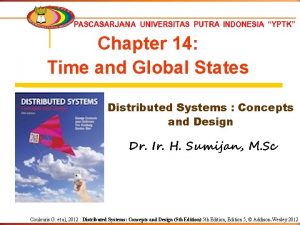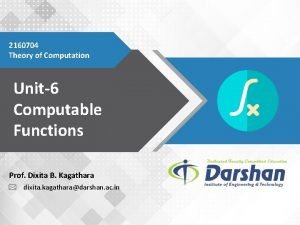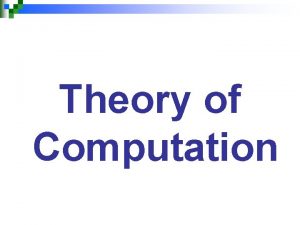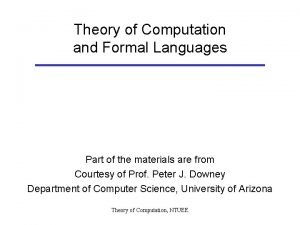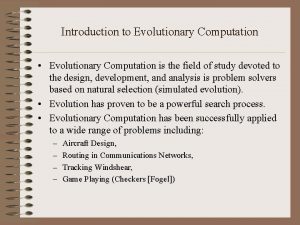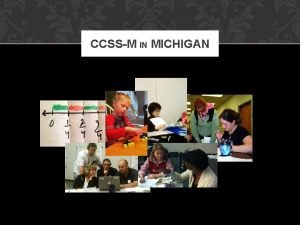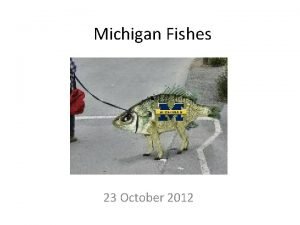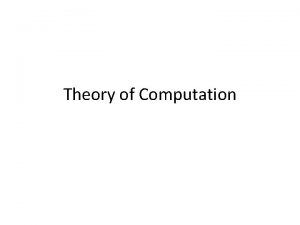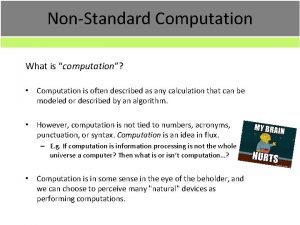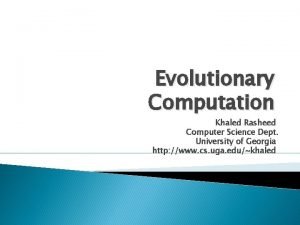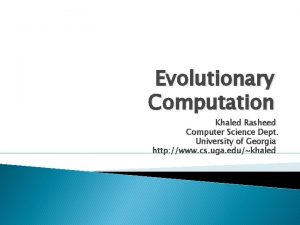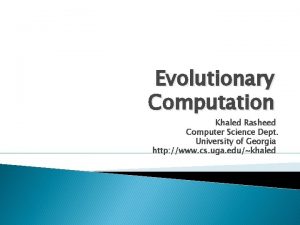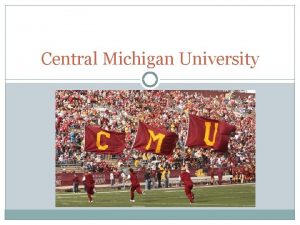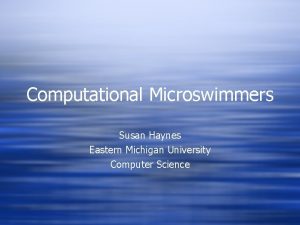Eastern Michigan University Introduction to Evolutionary Computation Matthew









































- Slides: 41

Eastern Michigan University Introduction to Evolutionary Computation Matthew Evett

Evolutionary Computation is…. § Umbrella term for machine learning techniques that are modeled on the processes of neo-Darwinian evolution. l l Genetic algorithms, genetic programming, artificial life, evolutionary programming Survival of the fittest, evolutionary pressure § Techniques for automatically finding solutions, or near solutions, to very difficult problems.

Why is EC Cool? § EC techniques have found solutions better than any previously known for many domains l Electronic circuit design, scheduling, pharmaceutical design § Autonomous solution discovery is fun l Look Ma! No hands!

Darwinian Evolution § Works on population scale, not individual § Chance plays a part l l Variation affects viability Fittest don’t always survive! § Heredity of traits § Finite resources to yield competition

EC is not. . . § “Real” evolution, or “real” genetics § It is modeled on natural genetic systems only in a simple sense. l l Term “genetic” is really used to mean “heredity” Real genetics is much more complicated

Overview of the Talk § We’ll look at two related techniques. . . l l genetic algorithms genetic programming § We’ll look at some demos of evolutionary systems.

History of EC § Friedberg’s induced compilers (1958) § Evolutionary Programming (1965) l Fogel, Owens & Walsh § Evolutionary Strategies (Recehenberg ‘ 72) § Genetic Algorithms (Holland ‘ 75) § Genetic Programming l l Tree-based GA (Cramer ‘ 85, Koza ‘ 89) “True” GP (Koza ‘ 92)

Basic evolutionary algorithm § Population of individuals, each representing a potential solution to the problem in question.

Genetic Algorithms (GA) § Population individuals are (fixed-length) binary strings (“genome”) § Start with a population of random strings. § Measure “fitness” of individuals. § Each generation forms a new population from old via recombination and mutation. § Solutions improve over generations.

Three steps to setting up a GA § 1) Devise a binary encoding representing the potential solutions to a problem. § 2) Define a fitness function. l Objective measure of quality of individual § 3) Set control parameters. l l l population size maximum number of generations probability of mutation and crossover, etc.

Example: Designing a Truss § 10 members § 16 diameters avail. l l Different costs Different strengths A 10 A 2 A 8 A 6 A 7 A 3 A 5 A 9 A 4 § Find cheapest that is strong enough 0010 1110 0001 0010 1111 0001 0110 1010 § 40 -bit genome 50 lb l Each 4 bit sequence reps. diam. of 1 member 50 lb

Running a GA § Generate an initial population of random binary strings § Calculate “fitness” of each individual l Fitness is cost of design, + penalty for fails § Create next generation l l l Select on the basis of “fitness” Recombination/mating Select some elements for mutation. • Typically one or two random bits will be flipped

Crossover in GA § Single-point crossover l 00101101 00101011 10010101 Parents Children There are many other forms § Randomly select crossover point § Swap crossover fragments § Offspring will have a combination of randomly selected parts of both parents

Running a GA (continued) § Repeatedly create new generations l Calculate fitness § Terminate when an acceptable solution is been found or when the specified maximum number of generations is reached.

Running a GA/GP § Major phases of evolutionary algorithms:

Results of Truss Example § Optimal solution is known, but rare l Number of possible designs is 240 § Typical run l 200 individuals/pop. ; 40 generations § Yields answer within 1% of optimal l …but examines only 8000 individuals! (. 0000007% of designs)

Genetic Programming (GP) l l GP is a domain-independent method for inducing programs by searching a space of Sexpressions. GP’s search technique is similar to GA’s. The elements of a population are programs, encoded as s-expressions. The Lisp programming language is based on sexpressions. • Original GP work was done in Lisp.

Genetic Programming Elements § S-expressions l l Prefix notation Programs, encoded as trees, evaluated via postorder traversal § Ex: tree corresponding to the S-expression l (sqrt ( / (+ a b) 2. 0 ) )

Representation of a Program § S-expressions can be converted to C…. float tree. Func(float a) { if ( a > 10. 0) { return 20. 0; } else { return a/2. 0; } } Looping constructs and subroutine calls are also possible.

Three steps to setting up a GP § Define appropriate set of functions and terminal set = {a, b, c, 0, 1, 2} terminals. l l Must have closure. function set ={+, -, *, /, SQRT} Functions and Terminals must be sufficient. § Define a fitness function. § Set control parameters. l l l GA population size, maximum size or depth of the individual trees size and the shape of the original trees, etc.

Starting a GP § Generate an initial population of random Sexpression trees. § Calculate fitness value for each individual l Often over a set of test cases.

Running a GP § Create the next generation (population) l Select elements for reproduction • Random, fitness-proportionate, tournament. l Reproduce: • Direct reproduction (cloning) • Mating – Mating method differs from GA’s. • Mutation – Also differs from GA’s.

GP Crossover § Randomly choose crossover points. § Swap rooted subtrees. § “Closure” property guarantees viability of offspring

Mutation with GP § Elements that are selected for mutation will have some randomly selected node (and any subtree under it) replaced with a randomly generated subtree. § Point mutation § Tree growth (shown here)

Running a GP (continued) § Repeatedly create new generations. § Terminate when an acceptable solution is found or when a specified maximum number of generations is reached. l The termination criteria is often based on a number of hits, where a hit is defined as the successful completion of some subgoal.

Example: Santa Fe Trail § Ant animats, acquiring food. l l Some gaps in trail 89 food “pellets” § Evolve control strategy to consume all pellets l In acceptable time

Representing “Ants” T = {ahead, left, right} F ={if-food-ahead, progn 2, progn 3} § “Terminals” are functions, whose evaluation causes ant to move. § Fitness = # of pellets consumed in 400 terminal evaluations. l Prevents infinite runs, and weak solutions. (if-food-ahead (move) (progn 2 (left) (move)))

Demo: Santa Fe Ant § During run, shows path of best-of-generation, best-of-run § Chong, 1998 l

Santa Fe Ant Demo (done) § http: //studentweb. cs. bham. ac. uk/~fsc/DGP. html § The applet

GP Generated Military Tactics § Squadron has a destination § Ordered either to: evade or attack § Porto, Fogel & Fogel, 1998 § Population of strategies

Generating tactics § Every 20 seconds of real time, do GP run, 40 generations. § Predicts 20 mins ahead. § Allows adaptation to changing situation. § Here, order is changed from “evade” to “attack”.

Co-evolution § Simulation uses GP-developed strategy for both squadrons.

Real-time success § Platform: Sparc 20 § Actual Pentagon military simulation. § Blue squad fires on red.

Learning to Walk with GP § Evolve control strategies for movement of arbitrarily articulated animats. l Karl Sims, 1995 § Fitness is rate of travel l l physics model LOTS of CPU cycles!

GA-learned bipedal motion § Individual strategies can be observed on the applet. (http: //www. jsh. net/and y/gat/environ. html) § User can view all trials, or just the best-ofgeneration. § Constrained skeletons. § Dick, 1998

Financial Symbolic Regression § The goal is time series prediction, where the target points are a financial time series. § In this case we are using a target time series derived from the daily closing prices of the S&P 500 from the years 1994 and 1995. § Uses 33 independent variables taken from time series that are derived from the S&P 500 itself and from the closing daily prices of 32 Fidelity Select Mutual Funds. § Evett & Fernandez, 1996, 1997.

Solving Financial Problems § The top line in the graph is the daily closing price of the S&P 500. The solid line below it is the graph of the target time series after preprocessing. § The dotted line is a function evolved using GP. It is included here only as an example to illustrate that criterion for success does not require a great deal of accuracy.

The Example Evolved Function § y = (((0. 38)-((-0. 20923)-(FSPTX-(((-0. 79706) /(0. 38))*((FSUTX-FSCSX)*(FSCGX-(0. 34247))))))) *(SPX*((0. 82794)/(0. 54431)))) l The independent variables that were used by this evolved function are derived from the following time series. • • • FSPTX FSUTX FSCSX FSCGX SPX Fidelity select Technology Portfolio. Fidelity Select Utility Portfolio Fidelity Select Software Portfolio Fidelity Select Capital Goods Portfolio S&P 500 Index

Conclusions § Evolutionary algorithms are a powerful technique for problem solving in domains that: l l are variable difficult, if not impossible to optimize § GP is especially useful for problems for which the form of the solution is not known. § Evolutionary techniques are becoming widespread.

Overview of the Software § § § Object Oriented C++. Windows 95 (MS Visual C++ 5. 0) Ported to UNIX. (GNU C++) Extended to run cooperatively on multiple machines using MPI.

Thank You! Are there any Questions?
 Sipser, m: introduction to the theory of computation
Sipser, m: introduction to the theory of computation Introduction to the theory of computation
Introduction to the theory of computation Common lisp a gentle introduction to symbolic computation
Common lisp a gentle introduction to symbolic computation Introduction to evolutionary computing
Introduction to evolutionary computing Eku aviation
Eku aviation University of eastern colorado firewatch
University of eastern colorado firewatch Metu computer center
Metu computer center University of michigan
University of michigan Western michigan university school of social work
Western michigan university school of social work Msu physics and astronomy
Msu physics and astronomy Michigan state orientation
Michigan state orientation Scott e page michigan
Scott e page michigan University of michigan automotive research center
University of michigan automotive research center University of canada
University of canada Livonia specialty center
Livonia specialty center Student actuaries at michigan
Student actuaries at michigan Nine dot problem
Nine dot problem Expanded withholding tax computation
Expanded withholding tax computation Expanded withholding tax computation
Expanded withholding tax computation Expanded withholding tax computation
Expanded withholding tax computation Form 2306
Form 2306 Fertilizer computation philrice
Fertilizer computation philrice Modeling computation discrete math
Modeling computation discrete math How to compute mcit
How to compute mcit Income tax computation format
Income tax computation format Crystalloids and colloids examples
Crystalloids and colloids examples Individual tax computation format
Individual tax computation format Efficient methods for data cube computation
Efficient methods for data cube computation Drug computation
Drug computation Data cube computation
Data cube computation Index de computation
Index de computation Drop per minute
Drop per minute Cuts of a distributed computation
Cuts of a distributed computation Theory of computation
Theory of computation Expanded withholding tax revenue regulation
Expanded withholding tax revenue regulation Net maintainable rent
Net maintainable rent Board feet calculator
Board feet calculator Transition diagram in theory of computation
Transition diagram in theory of computation Theory of computation
Theory of computation Pagerank computation
Pagerank computation Pagerank computation
Pagerank computation The pagerank citation ranking: bringing order to the web
The pagerank citation ranking: bringing order to the web

